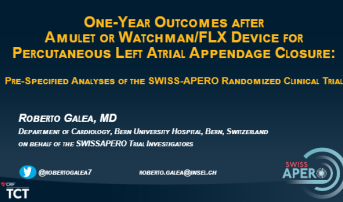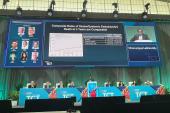Watchman, Amulet LAAO Devices Have Similar Leak Rates at About 1 Year
The SWISS-APERO analysis shows that roughly half of patients overall have patent appendages detected by CT.

SAN FRANCISCO, CA—Roughly half of patients who undergo left atrial appendage occlusion (LAAO) with one of the two most commonly used devices have incompletely sealed appendages 13 months after the procedure, as detected by CT, with no difference between occluders, according to a prespecified analysis of the SWISS-APERO trial.
The rate of LAA patency was 53.6% in patients treated with the Amplatzer Amulet (Abbott) and 48.8% in those treated with the Watchman 2.5 or FLX (Boston Scientific), a nonsignificant difference (P = 0.537), Roberto Galea, MD (Bern University Hospital, Switzerland), reported here at TCT 2023.
There were no differences in clinical outcomes either, although the study was not powered for those endpoints.
“Based on the data we have so far, I think both devices are good to protect our atrial fibrillation patients from ischemic stroke [over] the long term,” Galea said at a press conference, noting that SWISS-APERO included only patients with an LAA anatomy suitable for both devices. Anatomies amenable to treatment with the Amulet but not the Watchman—shallow appendages or those with proximal lobes—were excluded.
Vivek Reddy, MD (Icahn School of Medicine at Mount Sinai, New York, NY), discussed the results, which were published simultaneously online in Circulation, after Galea’s presentation. “Leaks matter,” said Reddy. “We didn’t think they mattered, but they matter quite a bit.”
High-quality studies have shown that leaks roughly double the rate of ischemic stroke and that patients without leaks have a low annualized stroke rate of about 1.3%, he said. “Trying to minimize and eliminate leaks is very important.”
In that context, Reddy said the rate of CT-detected leaks in SWISS-APERO remained “relatively high” at 50% at 13 months, despite a drop from about 70% at 45 days.
Galea agreed, but said “still we have to understand [what] is the clinical relevance of this leak as assessed by CT.” He noted that studies demonstrating a link between residual leaks after LAAO and higher rates of thromboembolic events have all used transesophageal echocardiography (TEE)—which is less sensitive than CT—to assess patency. The SWISS-APERO investigators will follow patients up to 5 years to allow for a look at the relationship between CT-detected leaks and clinical outcomes.
SWISS-APERO at 13 Months
The SWISS-APERO trial, which included 221 patients (mean age 77 years; 71% men), was the first randomized trial to directly compare the two most frequently used LAAO devices—Amulet and the Watchman (23% were treated with the first-generation 2.5 device, and the rest with the next-generation FLX). Initial results showed that at 45 days, LAA sealing was similar with both devices when assessed using cardiac CT angiography (CCTA) but worse with the Watchman when using TEE.
The current prespecified analysis takes follow-up out to 1 year, with investigators using CCTA to assess both LAA patency and device-related thrombus. Overall, 74% of patients were available to undergo imaging at that time point.
As with overall LAA patency, there were no differences between devices for various leak subtypes, including intradevice, peridevice, and mixed leaks, as well as patent LAAs with no visible leak on imaging.
Definite device-related thrombus (DRT) was detected in one patient in each arm of the trial, with no significant difference in the rate of definite/possible DRT between the Amulet and Watchman groups (2.4% vs 3.8%; P = 0.610).
In terms of clinical outcomes, a composite of CV death, ischemic stroke, or systemic embolism occurred in 9.5% of Amulet-treated patients and 10.2% of Watchman-treated patients at 13 months (P = 0.829), with no significant differences in the individual components or other endpoints, including bleeding.
The results were consistent in analyses restricted to patients treated with the newer Watchman FLX device.
The investigators also looked at how LAA patency changed among the subset of patients who underwent CCTA at both 45 days and 13 months, finding that 30.5% of appendages that were patent at the earlier time point became sealed over time. In 13.2% of cases, the appendage became patent after 45 days.
Is CCTA Too Sensitive?
In the discussion following his presentation, Galea suggested that perhaps CCTA is picking up too much when assessing appendage patency after LAAO, making it difficult to interpret the findings. With TEE, he said, there are clear definitions of peridevice leak, but with CT there is no consensus about how to define DRT or patency.
For that reason, Galea said, there is a need for a consensus document to establish definitions and then a prospective study to assess the relationship between CT-detected leaks and clinical events. He noted that a recent study showing an association between LAAO peridevice leaks and adverse outcomes assessed patency at 1 year, and not earlier time points.
Addressing the question of the best tools for evaluating leak, Reddy suggested that it might not matter whether it’s assessed using TEE or CT. “My guess is they’ll be very similar, and they’re both bad,” he said. “So in some ways I guess you could look at that as a little disappointing/depressing because that means we have a lot of leaks. On the other hand, the flip side is that also means that if we can occlude the appendage without having any leaks we’re going to improve our outcomes even better than we have.”
Todd Neale is the Associate News Editor for TCTMD and a Senior Medical Journalist. He got his start in journalism at …
Read Full BioSources
Galea R, Meneveau N, De Marco F, et al. One-year outcomes after Amulet or Watchman device for percutaneous left atrial appendage closure: a pre-specified analysis of the SWISS-APERO randomized clinical trial. Circulation. 2023;Epub ahead of print.
Disclosures
- The sponsor of SWISS-APERO, Insel Gruppe AG, Universitätsklinik für Kardiologie, was supported by local available funding and a research grant from Abbott.
- Galea reports no relevant conflicts of interest.
- Reddy reports holding equity/stocks/options from Endobar Solutions LLC; receiving grant support/research contracts from Abbott Vascular and Boston Scientific; and serving on a scientific advisory board for AtaCor Medical.






Comments